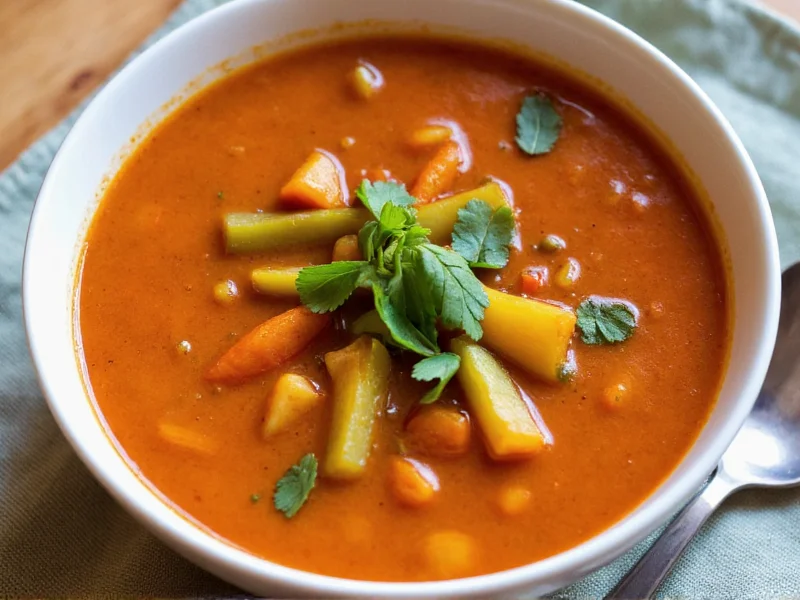The Secret to Truly Awesome Vegetable Soup
Many vegetable soups fall short because they either become mushy or lack depth of flavor. The difference between ordinary and extraordinary vegetable soup lies in technique, not complexity. By understanding vegetable chemistry and broth development, you can create restaurant-quality soup in your own kitchen.
Essential Ingredients for Maximum Flavor
Quality ingredients form the foundation of any healthy homemade vegetable soup that stands out from the crowd. Don't substitute key components if you want that "wow" factor.
| Ingredient | Quantity | Why It Matters |
|---|---|---|
| Homemade vegetable stock | 6 cups | Provides complex flavor base without artificial ingredients |
| Fresh mirepoix (carrots, celery, onion) | 1.5 cups diced | Creates aromatic foundation when properly sautéed |
| Garlic | 3 cloves | Adds depth when added at right temperature |
| Seasonal vegetables | 4 cups mixed | Ensures peak flavor and texture (see recommendations below) |
| Fresh herbs (parsley, thyme) | 2 tbsp chopped | Finishing touch that elevates the entire dish |
Step-by-Step Preparation Guide
Follow this professional technique for the best seasonal vegetable soup you've ever made. The sequence matters more than you might think.
1. Build Your Flavor Foundation
Sauté mirepoix in olive oil over medium heat for 8-10 minutes until translucent but not browned. Add garlic during the last 2 minutes. This gentle cooking releases natural sugars without burning, creating a sweet base for your soup.
2. Layer Your Vegetables Strategically
Add vegetables in order of cooking time:
- Root vegetables (potatoes, parsnips): First, need longest cooking
- Medium-cooking veggies (carrots, celery): After 5 minutes
- Quick-cooking vegetables (zucchini, bell peppers): Last 10 minutes
- Leafy greens (kale, spinach): Stir in during final 2 minutes
3. Master the Broth Balance
Pour in your stock gradually, bringing to a gentle simmer (not boil) after each addition. This controlled temperature prevents vegetables from becoming waterlogged while extracting maximum flavor.
4. The Finishing Touches
Remove from heat and stir in fresh herbs. For restaurant-quality depth, add one of these professional secrets:
- 1 tablespoon tomato paste (adds umami)
- 1 teaspoon soy sauce (enhances savory notes)
- 1 Parmesan rind (simmered in broth)
Avoid These Common Vegetable Soup Mistakes
Even experienced cooks make these errors when preparing easy vegetable soup recipe for beginners. Steer clear of these pitfalls:
Overcooking All Vegetables Together
Adding everything at once creates some vegetables that are mushy while others remain undercooked. The sequential addition method preserves ideal texture throughout.
Boiling Instead of Simmering
Vigorous boiling breaks down vegetables too quickly and clouds your broth. Maintain a gentle simmer where bubbles occasionally break the surface.
Seasoning Only at the End
Add 75% of your salt when sautéing the mirepoix. This allows flavors to develop properly throughout cooking rather than just sitting on the surface.
Customizing Your Vegetable Soup
Adapt this vegetable soup recipe with seasonal ingredients to suit your dietary needs and preferences:
Dietary Modifications
- Vegan option: Use vegetable stock and omit Parmesan rind
- Gluten-free: Naturally compliant (verify stock ingredients)
- Low-sodium version: Use unsalted stock and increase herbs
Seasonal Vegetable Recommendations
- Spring: Asparagus, peas, fresh green beans
- Summer: Zucchini, yellow squash, tomatoes
- Fall: Butternut squash, sweet potatoes, mushrooms
- Winter: Kale, cabbage, turnips, parsnips
Storage and Reheating for Best Results
Proper storage maintains quality when making vegetable soup for meal prep:
- Cool completely before storing (prevents condensation)
- Store in airtight containers for up to 5 days
- Freeze in portion-sized containers for up to 3 months
- Reheat gently on stove (not microwave) to preserve texture
Flavor actually improves after 24 hours as ingredients meld. For best results, make this soup a day ahead when possible.
Serving Suggestions for Restaurant-Quality Presentation
Elevate your homemade vegetable soup presentation with these professional touches:
- Garnish with a swirl of pesto or a drizzle of good olive oil
- Add a sprinkle of fresh herbs just before serving
- Include crusty bread on the side for dipping
- For heartier meals, add cooked grains like quinoa or barley
Frequently Asked Questions
Can I use frozen vegetables in this vegetable soup recipe?
Yes, frozen vegetables work well in vegetable soup, though fresh seasonal produce delivers superior texture and flavor. If using frozen, add them directly from frozen without thawing, but reduce cooking time by 3-5 minutes to prevent mushiness. Peas, corn, and green beans freeze particularly well for soup applications.
How do I prevent my vegetable soup from becoming too watery?
To avoid watery vegetable soup, reduce your stock by 25% before adding vegetables, or simmer uncovered during the final 15 minutes of cooking. Another technique is to remove 1-2 cups of vegetables and broth, blend until smooth, then return to the pot. This thickens the soup while maintaining fresh vegetable texture.
What's the best way to add protein to vegetable soup without meat?
Excellent plant-based protein options for vegetable soup include adding 1 cup of cooked lentils, white beans, or chickpeas during the last 10 minutes of cooking. For a creamier texture with protein, stir in 1/2 cup of blended silken tofu at the end. These additions boost nutrition without overpowering the vegetable flavors.
Why does my vegetable soup lack depth of flavor?
Vegetable soup often lacks depth when the mirepoix isn't properly caramelized, insufficient seasoning is used throughout cooking, or the stock lacks complexity. For richer flavor, sauté vegetables until golden (not just translucent), season in layers, and consider adding umami boosters like tomato paste, dried mushrooms, or a Parmesan rind during simmering.











 浙公网安备
33010002000092号
浙公网安备
33010002000092号 浙B2-20120091-4
浙B2-20120091-4